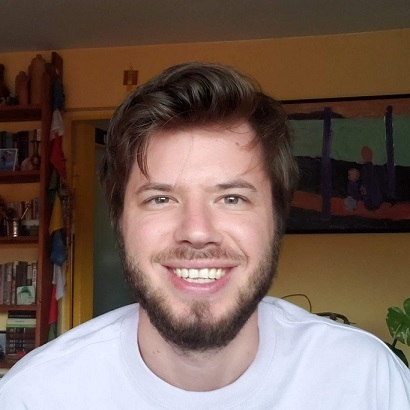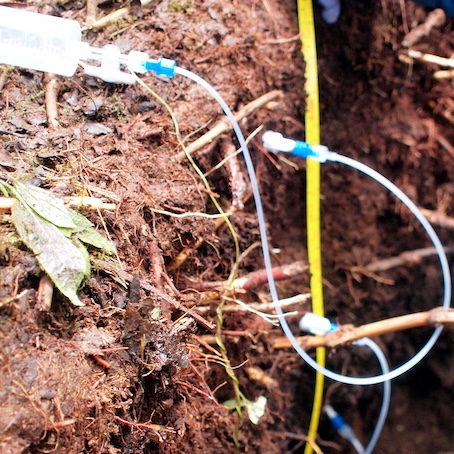Staff profile

| Affiliation | Telephone |
|---|---|
| Assistant Professor in the Department of Earth Sciences | +44 (0) 191 33 42333 |
Biography
The interaction of rocks with water shapes landscapes, supplies nutrients to ecosystems, and modulates Earth’s climate. As a result, there is a delicate and complex balance between tectonics, rock weathering, and our planet’s ability to sustain life. My research is aimed at quantifying and mechanistically understanding the biogeochemical processes that underpin this balance in the Earth surface environment. This work spans a wide range of spatial and temporal scales – from water-sediment interface at the ocean floor, to world’s largest river basins. I employ an interdisciplinary approach that combines field studies, controlled lab experiments, and computer models of varying complexity. I particularly focused on investigating mineral-water reactions (weathering and diagenesis) in freshwater and marine environments, by developing and coupling a multitude of isotopic and geochemical tracers – elemental and isotopic ratios of Si, Ge, C, SO4, H2O, Sr, Nd, and others.

Previous employment & education
2021-2023 - Marie Sklodowska-Curie Fellow, Institut de Physique du Globe de Paris, France
2017-2020 - Postdoctoral Research Associate, Cambridge University, UK
2011-2017 - PhD in Earth Sciences, University of Southern California, USA
2011-2014 - MS in Earth Sciences, University of Southern California, USA
2008-2011 - BSc in Chemistry, Jacobs University Bremen, Germany
Available positions
I am always looking for curious and motivated Masters and PhD students or postdocs, interested in figuring out how the Earth works. I will list any specific upcoming opportunities below, but feel free to reach out any time, if you are interested in the kind of work I do and would like to develop a research project together. For graduate study entry requirements to Durham, refer to this page.
There are usually opportunities available for fully funded PhDs (for either UK or international students) every year, with the application deadline in January. Contact me, if you are interested in doing a PhD on the topics I work on.

Ongoing research
Biogeochemical cycling in Earth surface environments
A lot of the work we do is aimed at understanding the bi-directional feedback between Earth surface conditions (climate, water flow, atmospheric composition) and various biogeochemical reactions. Specifically, we focus on how the elemental and isotopic signatures of sulfur, silicon, carbon, oxygen, and other elements can help us trace the various processes taking place in soils, rivers, and oceans. Recent and ongoing projects include constraining the role of glaciers in modulating silicate weathering in Iceland, quantifying mineral and plant uptake of silicon in catchments around the world, and developing novel isotope proxies as tracers of biogeochemical processes in terrestrial and marine environments. Much of this work is done in collaboration with researchers in Durham, Cambridge, Rice University, and elsewhere.
The role of hydrology and soil processes in controlling silicate weathering (PI, funded by EU H2020 MSCA)
In this work we use a combination of hydrologic and geochemical isotopic tracers to investigate how water flow determines the types and rates of biogeochemical reactions taking place in the environment. This work spans a number of different research projects, with study sites in the South America, Southeast Asia, and the UK. In some cases, the field studies are combined with lab experiments simulating different mineral-water reactions under controlled conditions. Most recently, this work has focused on the Capesterre river catchment in the Guadeloupe island, in collaboration with Institut de Physique du Globe de Paris and the ObsERA Critical zone observatory.
Carbon and sediment fluxes in world’s largest river basins (co-I, funded by NERC)
Large river systems in tropical regions are hotspots of weathering and zones of major carbon transfer from the atmosphere and continents to the oceans. The same weathering reactions also provide nutrients that sustain agriculture over entire continents. Recent work has shown that this carbon transfer is not as simple as thought previously, and multiple competing processes, such as oxidation of organic matter and weathering of pyrite-rich carbonate rocks could actually release CO2 back the atmosphere. Critical regions in Southeast Asia have especially been neglected due to logistical hurdles, despite accounting for a large portion of global weathering and carbon fluxes. In collaboration with Ed Tipper, Mike Bickle (Cambridge University), Bob Hilton (Oxford University), and others, we are working to address this gap. Given the large size of these basins, the results will yield a better understanding of the geological controls on Earth’s global climate. We also aim to assess some of the impacts of the extensive damming and other anthropogenic activities currently taking place in the region, as the environment attempts to rapidly adjust to the accelerating influence of humankind. This research will help quantify how damming affects sediment and nutrient fluxes in the region, which will impact downstream communities and ecosystems in the decades to come.
Tracing sulfur-driven greenhouse gas release from the boreal landscape (co-PI, funded by Durham-Uppsala Seedcorn Grant)
Led by Cat Hirst, this project investigates how the coupled sulfur and carbon cycles in boreal soils are being impacted by climate change. For example, soil drying can increase sulfide mineral dissolution, which in turn can acidify soils and release CO2, or conversely more efficiently oxidize methane that would otherwise be released to the atmosphere. Changes in the sulfur cycle may therefore lead to either positive or negative climate feedback mechanisms. In collaboration with Uppsala University, we are working to identify the net effect of hydrological variations on greenhouse gas emissions from sulfide rich environments.

Full publication list on Google Scholar.
Research interests
- Biogeochemistry
- Critical Zone science
- Environmental science
- Isotope geochemistry
- Rock-water interaction
- River hydrochemistry
Esteem Indicators
- 2023: Goldschmidt conference session convener: Dynamics and tracers of biogeochemical processes in the Critical Zone
- 2022: EU Horizon Europe MSCA expert reviewer:
- 2022: Keynote at Isotopes in Biogenic Silica conference: Germanium so hot right now: tracing Si cycle using Ge isotopes and Ge/Si ratios
- 2021: Marie Sklodowska-Curie Fellowship:
- 2021: Goldschmidt conference session convener: Critical zone processes across space and time
- 2021: PhD committee member: Yi Hou (Rice University, USA, Advisor: Mark Torres)
- 2019: Goldschmidt conference session convener: Understanding the Critical Zone Using the Composition of Particles, Solutes, and Gases Transported by Rivers
Publications
Journal Article
- Dellinger, M., Hilton, R. G., Baronas, J. J., Torres, M. A., Burt, E. I., Clark, K. E., …West, A. J. (2023). High rates of rock organic carbon oxidation sustained as Andean sediment transits the Amazon foreland-floodplain. Proceedings of the National Academy of Sciences, 120(39), Article e2306343120. https://doi.org/10.1073/pnas.2306343120
- Bridgestock, L., Henderson, G. M., Holdship, P., Khaing, A. M., Naing, T. T., Myint, T. A., …Bickle, M. (2022). Dissolved trace element concentrations and fluxes in the Irrawaddy, Salween, Sittaung and Kaladan Rivers. Science of the Total Environment, 841, Article 156756. https://doi.org/10.1016/j.scitotenv.2022.156756
- Schwab, M. S., Hilton, R. G., Haghipour, N., Baronas, J. J., & Eglinton, T. I. (2022). Vegetal Undercurrents—Obscured Riverine Dynamics of Plant Debris. Journal of Geophysical Research: Biogeosciences, 127(3), Article e2021JG006726. https://doi.org/10.1029/2021jg006726
- Relph, K. E., Stevenson, E. I., Turchyn, A. V., Antler, G., Bickle, M. J., Baronas, J. J., …Tipper, E. T. (2021). Partitioning riverine sulfate sources using oxygen and sulfur isotopes: Implications for carbon budgets of large rivers. Earth and Planetary Science Letters, 567, Article 116957. https://doi.org/10.1016/j.epsl.2021.116957
- Larkin, C. S., Piotrowski, A. M., Hindshaw, R. S., Bayon, G., Hilton, R. G., Baronas, J. J., …Tipper, E. T. (2021). Constraints on the source of reactive phases in sediment from a major Arctic river using neodymium isotopes. Earth and Planetary Science Letters, 565, Article 116933. https://doi.org/10.1016/j.epsl.2021.116933
- Urban, L., Holzer, A., Baronas, J. J., Hall, M. B., Braeuninger-Weimer, P., Scherm, M. J., …Stammnitz, M. R. (2021). Freshwater monitoring by nanopore sequencing. eLife, 10, https://doi.org/10.7554/elife.61504
- Tipper, E. T., Stevenson, E. I., Alcock, V., Knight, A. C. G., Baronas, J. J., Hilton, R. G., …Hughes, G. (2021). Global silicate weathering flux overestimated because of sediment–water cation exchange. Proceedings of the National Academy of Sciences, 118(1), Article e2016430118. https://doi.org/10.1073/pnas.2016430118
- Baronas, J. J., Hammond, D. E., Bennett, M. M., Rouxel, O., Pitcher, L. H., & Smith, L. C. (2021). Ge/Si and Ge Isotope Fractionation During Glacial and Non-glacial Weathering: Field and Experimental Data From West Greenland. Frontiers in Earth Science, 9, Article 551900. https://doi.org/10.3389/feart.2021.551900
- Torres, M. A., & Baronas, J. J. (2021). Modulation of Riverine Concentration‐Discharge Relationships by Changes in the Shape of the Water Transit Time Distribution. Global Biogeochemical Cycles, 35(1), Article e2020GB006694. https://doi.org/10.1029/2020gb006694
- Baronas, J. J., Hammond, D. E., Rouxel, O. J., & Monteverde, D. R. (2019). A First Look at Dissolved Ge Isotopes in Marine Sediments. Frontiers in Earth Science, 7, Article 162. https://doi.org/10.3389/feart.2019.00162
- Baronas, J. J., Torres, M. A., West, A. J., Rouxel, O., Georg, B., Bouchez, J., …Hammond, D. E. (2018). Ge and Si isotope signatures in rivers: A quantitative multi-proxy approach. Earth and Planetary Science Letters, 503, 194-215. https://doi.org/10.1016/j.epsl.2018.09.022
- Monteverde, D. R., Sylvan, J. B., Suffridge, C., Baronas, J. J., Fichot, E., Fuhrman, J., …Sañudo-Wilhelmy, S. A. (2018). Distribution of Extracellular Flavins in a Coastal Marine Basin and Their Relationship to Redox Gradients and Microbial Community Members. Environmental Science and Technology, 52(21), 12265-12274. https://doi.org/10.1021/acs.est.8b02822
- Baronas, J. J., Hammond, D. E., McManus, J., Wheat, C. G., & Siebert, C. (2017). A global Ge isotope budget. Geochimica et Cosmochimica Acta, 203, 265-283. https://doi.org/10.1016/j.gca.2017.01.008
- Baronas, J. J., Torres, M. A., Clark, K. E., & West, A. J. (2017). Mixing as a driver of temporal variations in river hydrochemistry: 2. Major and trace element concentration dynamics in the Andes‐Amazon transition. Water Resources Research, 53(4), 3120-3145. https://doi.org/10.1002/2016wr019729
- Torres, M. A., Baronas, J. J., Clark, K. E., Feakins, S. J., & West, A. J. (2017). Mixing as a driver of temporal variations in river hydrochemistry: 1. Insights from conservative tracers in the Andes‐Amazon transition. Water Resources Research, 53(4), 3102-3119. https://doi.org/10.1002/2016wr019733
- Baronas, J. J., Hammond, D. E., Berelson, W. M., McManus, J., & Severmann, S. (2016). Germanium–silicon fractionation in a river-influenced continental margin: The Northern Gulf of Mexico. Geochimica et Cosmochimica Acta, 178, 124-142. https://doi.org/10.1016/j.gca.2016.01.028

